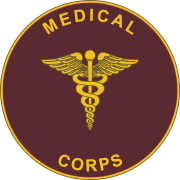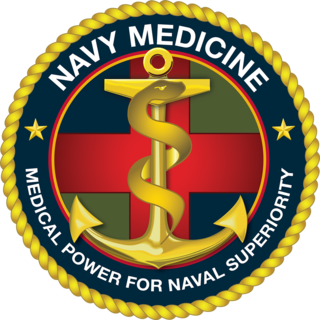
Fort Sam Houston is a U.S. Army post in San Antonio, Texas. Known colloquially as "Fort Sam," it is named for the U.S. Senator from Texas, U.S. Representative from Tennessee, Tennessee and Texas governor, and first president of the Republic of Texas, Sam Houston.
The Combat Capabilities Development Command Soldier Center, formerly the United States Army Natick Soldier Research, Development and Engineering Center, is a military research complex and installation in Natick, Massachusetts, charged by the U.S. Department of Defense with the research and development of food, clothing, shelters, airdrop systems, and other servicemember support items for the U.S. military. It is a component unit of the United States Army Combat Capabilities Development Command and is a tenant unit of the United States Army Natick Soldier Systems Center (SSC). The installation includes facilities from all the military services, not just the Army, and is so configured to allow cross-service cooperation and collaboration both within the facility and with the many academic, industrial and governmental institutions in the Greater Boston Area.

The U.S. Army Medical Command (MEDCOM) is a direct reporting unit of the U.S. Army that formerly provided command and control of the Army's fixed-facility medical, dental, and veterinary treatment facilities, providing preventive care, medical research and development and training institutions. On 1 October 2019, operational and administrative control of all military medical facilities transitioned to the Defense Health Agency.

The Walter Reed Army Medical Center (WRAMC), officially known as Walter Reed General Hospital (WRGH) until 1951, was the U.S. Army's flagship medical center from 1909 to 2011. Located on 113 acres (46 ha) in Washington, D.C., it served more than 150,000 active and retired personnel from all branches of the United States Armed Forces. The center was named after Walter Reed, a U.S. Army physician and sergeant who led the team that confirmed that yellow fever is transmitted by mosquitoes rather than direct physical contact.

The Army Medical Department of the U.S. Army (AMEDD), formerly known as the Army Medical Service (AMS), encompasses the Army's six medical Special Branches. It was established as the "Army Hospital" in July 1775 to coordinate the medical care required by the Continental Army during the Revolutionary War. The AMEDD is led by the Surgeon General of the U.S. Army, a lieutenant general.

The U.S. Army Veterinary Corps is a staff corps of the U.S. Army Medical Department (AMEDD) consisting of commissioned veterinary officers and Health Professions Scholarship Program (HPSP) veterinary students. It was established by an Act of Congress on 3 June 1916. Recognition of the need for veterinary expertise had been evolving since 1776 when General Washington directed that a "regiment of horse with a farrier" be raised. It has evolved to include sanitary food inspectors and animal healthcare specialists.

The Medical Corps (MC) of the U.S. Army is a staff corps of the U.S. Army Medical Department (AMEDD) consisting of commissioned medical officers – physicians with either an M.D. or a D.O. degree, at least one year of post-graduate clinical training, and a state medical license.

Valley Forge General Hospital is a former military hospital in Phoenixville, Pennsylvania. The hospital was near both Philadelphia, Pennsylvania and Valley Forge. It was the only United States Army General Hospital named for a place.

William Beaumont Army Medical Center is a Department of Defense medical facility located in Fort Bliss, Texas. It provides comprehensive care to all beneficiaries including active duty military, their family members, and retirees. The hospital is located in the Central/Northeastern part of El Paso, and provides emergency department services for Northeast El Paso. The current 1.1-million-square-foot, 6-building medical complex opened July 10, 2021 on East Fort Bliss. WBAMC is affiliated with the Paul L. Foster School of Medicine which is also located in El Paso, Texas. WBAMC is also a participating hospital for medical residents from the Uniformed Services University of the Health Sciences (USU) and nursing students from the University of Texas at El Paso School of Nursing and the El Paso Community College Nursing School. The current commander of WBAMC is Colonel Brett Venable.

The U.S. Army Test and Evaluation Command, or ATEC, is a direct reporting unit of the United States Army responsible for developmental testing, independent operational testing, independent evaluations, assessments, and experiments of Army equipment.

The Walter Reed Army Institute of Research (WRAIR) is the largest biomedical research facility administered by the U.S. Department of Defense (DoD). The institute is centered at the Forest Glen Annex, in the Forest Glen Park part of the unincorporated Silver Spring urban area in Maryland just north of Washington, DC, but it is a subordinate unit of the U.S. Army Medical Research and Development Command (USAMRDC), headquartered at nearby Fort Detrick, Maryland. At Forest Glen, the WRAIR has shared a laboratory and administrative facility — the Sen Daniel K. Inouye Building, also known as Building 503 — with the Naval Medical Research Center since 1999.

The United States Army Pigeon Service was a unit of the United States Army during World War I and World War II. Their assignment was the training and usage of homing pigeons for communication and reconnaissance purposes.

The Madigan Army Medical Center, located on Joint Base Lewis-McChord just outside Lakewood, Washington, is a key component of the Madigan Healthcare System and one of the largest military hospitals on the West Coast of the United States.

The Combat Capabilities Development Command, is a subordinate command of the U.S. Army Futures Command. RDECOM was tasked with "creating, integrating, and delivering technology-enabled solutions" to the U.S. Army. It is headquartered at Aberdeen Proving Ground in Maryland.
The United States Army Medical Research and Development Command (USAMRDC) is the United States Army's medical materiel developer, with responsibility for medical research, development, and acquisition.

The Bureau of Medicine and Surgery (BUMED) is an agency of the United States Department of the Navy that manages health care activities for the United States Navy and the United States Marine Corps. BUMED operates hospitals and other healthcare facilities as well as laboratories for biomedical research, and trains and manages the Navy's many staff corps related to medicine. Its headquarters is located at the Defense Health Headquarters in Fairfax County, Virginia. BUMED has 41,930 medical personnel and more than a million eligible beneficiaries.

The Communications-Electronics Command (CECOM) is a Life Cycle Management Command (LCMC) of the United States Army based at Aberdeen Proving Ground, Maryland, United States. It is one of four such commands under the Army Materiel Command (AMC), and is the Army's provider and maintainer of Command, Control, Communications, Computers, Cyber, Intelligence, Surveillance and Reconnaissance (C5ISR) capabilities.

The U.S. Army Medical Center of Excellence (MEDCoE) is located at Fort Sam Houston, Joint Base San Antonio, Texas. MEDCoE comprises the 32d Medical Brigade, the U.S. Army Medical Professional Training Brigade (MPTB), and the AMEDD Noncommissioned Officers Academy (NCOA). It serves the U.S. Army in educating and training all of its medical personnel. The Center formulates the Army Medical Department's (AMEDD's) organization, tactics, doctrine, equipment, and academic training support. In 2015, the mission for the Academy of Health Sciences (AHS) moved from the School to the Center, and was renamed the Department of Training and Academic Affairs (DoTAA) as result of a reorganization.

The 28th Combat Support Hospital was a Combat Support Hospital of the United States Army. It was first constituted in 1943 and served in China during World War II. During the Gulf War in 1990, it was the first Army hospital unit established and deployed into Iraq with combat forces of the XVIII Airborne Corps. More recently it has been involved in relief operations following natural disasters and has undertaken several recent deployments to Iraq. The unit fell under the command of the 44th Medical Brigade and was based at Fort Bragg, North Carolina.
Military Whistleblower Protection Act of 1988 (MWPA), as amended at title 10, United States Code, Section 1034, and elsewhere, is an American law providing protection of lawful disclosures of illegal activity by members of the United States Armed Forces.



















